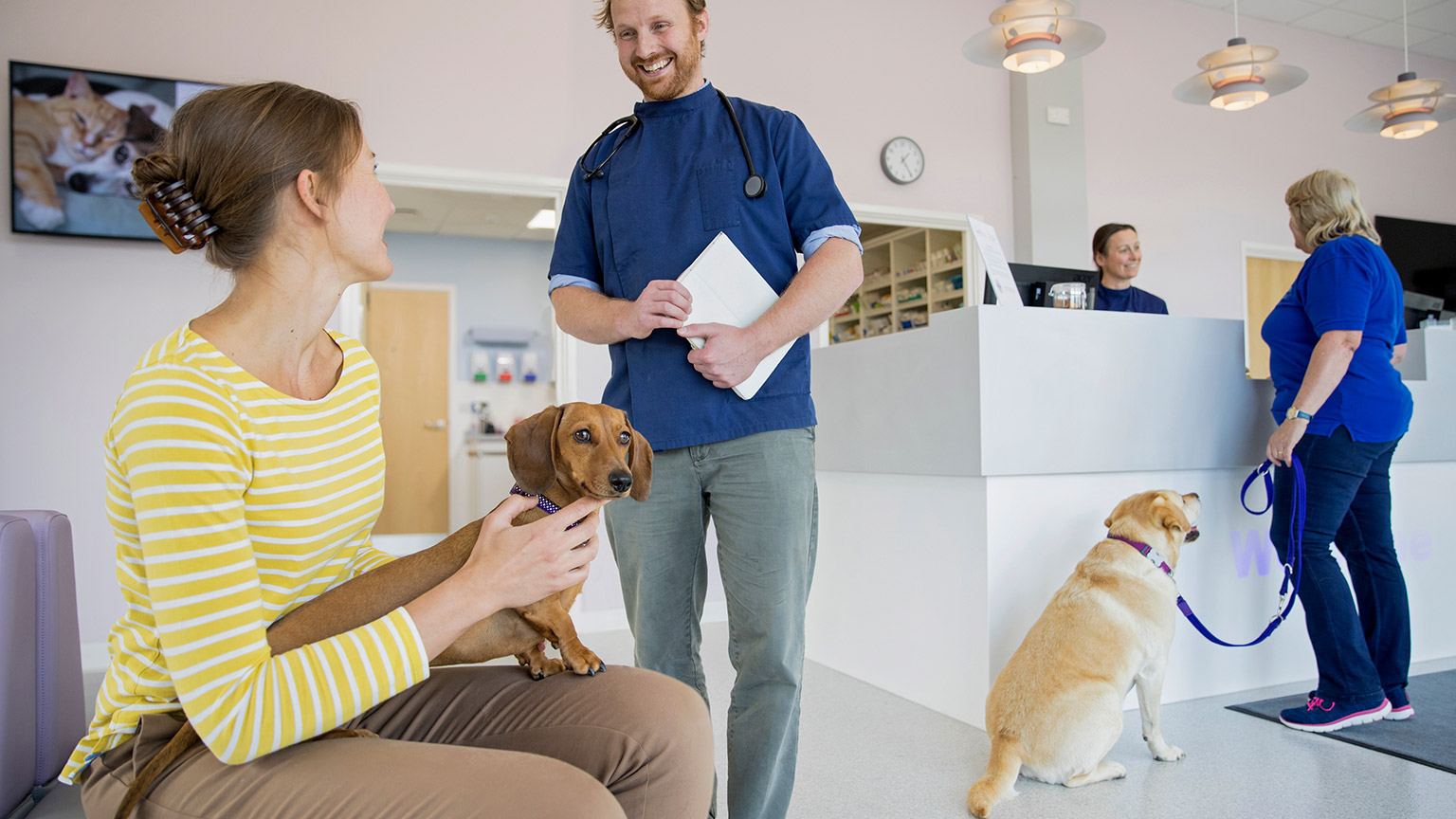Providing reception services at an animal care clinic is critical to the facility's overall operation. The reception area serves as the first point of contact for clients, and the quality of the service provided can significantly impact their experience and perception of the clinic. Here’s why offering excellent reception services is important.
Offering high-quality reception services at an animal care clinic is essential for ensuring a positive client experience, efficient clinic operations, and effective communication between clients and the veterinary team. The receptionist plays a pivotal role in building trust, managing client interactions, and supporting the clinic’s overall mission of providing excellent animal care.
As we have established, the Reception is the hub of any animal care clinic; it is the first point of contact, whether it be face-to-face, phone, email, etc.
Some crucial aspects that the reception covers are in the following table:
| First Impressions and Client Experience |
|---|
|
| Client Management |
|
| Communication and Information |
|
| Administration Tasks |
|
| Client Retention and Communication |
|
| Supporting the team |
|
| Customer Relations |
|
Watch
The next video explains some of the key factors you need to be great at working on reception.
The next video demonstrates the difference between good customer service and bad customer service.
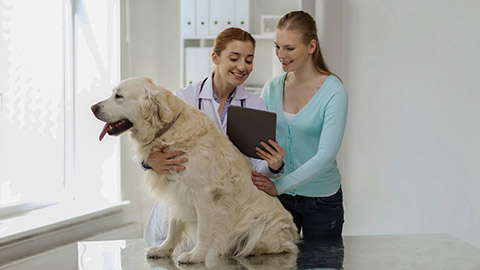
Financial and Administrative Procedures Relative to Receptionist Role in an Animal Care Facility
One of the many questions that customers/clients will ask when they make an enquiry or an appointment is, “How much will that cost?” So, you will have to answer many questions within your organisation. It is important to remember that all people who shop around are potential customers/clients.
It is important that you remember that when a customer s/client comes to your business either for the first time or the hundredth time, you are the first person that they will meet. What and how you speak to them and the information you provide to them will help you decide whether to choose your facility or stay with your facility.
Who Are People That Shop Around?
As you may be aware there are a number of people that will call up a business and ask for the price of a service, these people are shopping around to find the best price, but also, they will be listening to see who has the best services.
Even though these people are strangers, and you may never have spoken to them before, you will know two important facts about them, this being:
- They have a pet
- They are going to spend money in your business for services provided
It is, therefore, vitally important that you have the ability to sell your facility and show them that your facility has the ability and skill to provide a service to their pets.
Communicating Service Value
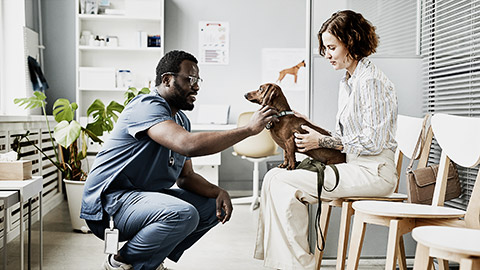
You may not know or understand, but giving price information to customers/clients is much more involved than what it looks like or more than just knowing the cost of a groom or even a long stay in a kennel or cattery.
You need to know general information about the services your facility offers, what animals can access, and the costs associated with the services. This information will vary depending on the facility you work at but could include information on the following:
- Preventative medications such as flea, worming and tick medications
- Grooming requirements for different species and breeds
- General information regarding products the facility sells, including brushes, shampoos, toys, and beds
- Vaccinations
- Boarding information
- Prices associated with all products and services provided by the facility
Imagine if you walked into a clothing shop and asked for a suit, and the staff member stated that it was $500.00 dollars. You may think that it is expensive, and you might leave, but if the salesperson had explained that the suit was 100% cotton, tailored, and washable and then given you the price, you might have thought about buying the product.
One of the most important jobs as a receptionist in any organisation is to communicate the value of your business. Anyone can quote a price over the phone, so it is important that you are able to explain to the client the reason why the services are priced the way they are. It is part of your job as the receptionist to be able to explain to the client the fee and the type of service they will receive, to make them feel that they are getting the best service for the cost, and to show that the staff at your business have their pet’s best interest in mind.
Case Study
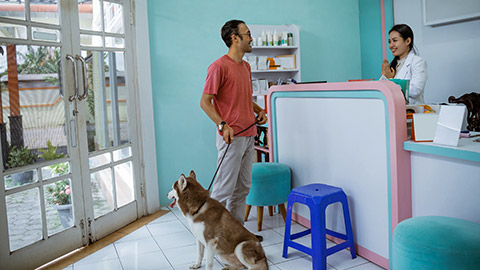
You work at the reception desk when a customer comes up to reception to inquire about the on-site boarding facility. The customer asks you how much it will cost to board their dog for 2 weeks. The customer advises that their dog is recovering from surgery and must be on medication twice a day while at the facility.
How would you respond? What would you do next?
- As this is a complicated case, you would need to talk to the boarding facility manager, as well as a vet, to find out if the pet's medical needs are something that can be accommodated whilst they stay at the facility
- Will this require additional care that may incur a cost
- What considerations need to be made to the pet whilst in care (do they need to be observed during recovery, are their limitations on what they can do with exercise, etc)
Watch
The next video explains the value of good customer service.

You will find that nearly all facilities will keep a list of services and the prices of those services. (See example below)
| Grooming services | |
|---|---|
| Wash & dry | $59.95 |
| Summer clip (small dog) | $49.00 |
| Summer clip (medium dog) | $69.00 |
| Summer clip (large dog) | $89.00 |
| Deluxe groom | $120.00 |
| Nail clip | $15.00 |
When you first start your new job, it is important that you are able to locate a copy of the price list and that it is up-to-date. If you quote an old price, this will cause confusion and possibly mistrust when it is time for the client to pay the bill.
Even though you need not have to memorise the whole bill, it is important if can remember the prices for main services such as an overnight stay or dog shampoo, “DO NOT” panic if you cannot remember you will always have the price list with you (photocopy the list and keep it with you).
If new customers/clients call (they might be just comparing different clinic prices), you may want to obtain their names and contact details so that you can send them the information about the service and fees. This will help them remember you and make you look professional.
When You Do Not Know the Price of Services
When working the reception area, you will often receive a phone call from a possible or existing client asking for a quote for a service such as:
The client would like to board 2 cats for a week. Mojo, the ginger cat, is medicated daily. The medication is insulin and requires an injection to be given.
Because this is not a straightforward booking and will require additional work by the staff, you will need to seek help from your supervisor.
The next Case Study is an example of what quotes from an animal care clinic look like and what some of the services are.
Case Study
Happy Paws Animal Care Facility
Veterinary Services
| Initial Consult | $75 |
| Follow Up Consultation | $50 |
| Emergency Consultation (After Hours) | $120 |
|
Vaccinations
|
|
| Microchipping | $45 |
|
Spraying/ Neutering
|
|
|
Dental Cleaning
|
|
Diagnostics
|
Blood Tests
|
|
|
Xrays
|
|
| Ultrasound | $250 |
| Urinalysis | $40 |
| Fecal Test | $30 |
Grooming Services
| Basic Bath (Includes nail trim and ear cleaning) | $40-60 (depending on size) |
| Full Groom (Includes haircut, bath, nail trim, and ear cleaning) | $70-$100 (depending on size) |
| Nail Trim | $15 |
| De-shedding Treatment | $50-$80 (depending on size) |
| Teeth Brushing | $20 |
Boarding Services
Standard Boarding
| Small Animals | $25 |
| Medium Dogs | $35 |
| Large Dogs | $45 |
Luxury Boarding (Including extra playtime and treats)
| Small Animals | $40 |
| Medium Dogs | $55 |
| Large Dogs | $65 |
Daycare
| Half Day | $20 |
| Full Day | $35 |
Other services include:
- Training Services
- Pet Nutrition and Retail
- End-of-Life Services

It is important to remember that your business is not a charity or lending institution. It is, therefore, that your business will have a policy for payment most clinic's policy is very simple:
- Payment is due when the services are rendered
Ideally, all fees should be collected at the time of the end of the service provided; some businesses may provide payment services such as:
- Cash
- EFTPOS
- Credit agreement
- Vet Pay
- Charge account
- Cheque
Payment by Cash

This is the easiest way for clients to pay because there is no verification necessary. It simply requires the client to give you the cash, then for you to count the cash, place it on top of the till and give the client any change that is required, print the invoice off and hand it to the client, then place the cash into the till.
Payment by Cheque

If your business accepts cheques, they are more than likely, like most businesses, to accept personal cheques. This means that only cheques that are written on the client's personal account are made payable to your clinic.
When you accept a cheque from a client, it is very important that you verify the details as they are on the Cheque, these include:
- Client’s name
- Address
- Contact details
If the client gives you a post office box number, it is important that you obtain their actual street address, if you can obtain a copy of their driver’s license (note any discrepancies on their file)
When accepting cheques, keep in mind:
- Make sure the license is signed
- Never accept a check that is post-dated
- Never accept a cheque that is not dated
- Never accept a cheque that is older than ten days
- Make sure that the numerical figure agrees with the amount written on the cheque
If you have any doubts about the validity of the cheque, then you should not accept it.
Payment by Credit Card

When accepting credit card (EFTPOS) payment, it is important that you verify the following:
- Name on the card
- Expiry date
Your clinic will more than likely use an Electronic Fund Transfer Point of Sale.
- Obtain credit/visa card from the owner
- Swipe/insert card into EFTPOS machine
- Enter amount
- Press “ENTER”
Request the Owner to select the account and enter the pin number
- The machine will print out the “MERCHANT COPY” docket
- Press “ENTER” again and print out “CUSTOMER COPY.”
- Click on payment and select “CASH/EFTPOS.”
- Click on “FINISH.”
Some EFTPOS machines will also have the “PAY-WAVE” facility. This allows you or the client to swipe the card over the reader, and if it is less the $100.00, then there is no PIN required. If the price is above $100.00, then the customer will have to enter a PIN.
Once you have completed the transaction with the customer, it is important that you still communicate with the customer at the end of the transaction, especially when you tender their change. Remember it is the last image of your store and your customer service they remember, so make it professional.
Sometimes, you will get a call from a customer who would like to pay for a service over the phone using their credit card. One thing to make sure you do is keep the customer's privacy and confidentiality.
For Example:
A customer has called the reception desk to pay their cat's account over the phone using a credit card. You are sitting at reception, and 3 customers are waiting to be served, and 4 others are sitting in the waiting room.
What to do?
- To help keep confidentiality and privacy, you could excuse yourself from the reception, find a private space and complete the call. However, if it is you at the reception, this cannot be done at times.
- You could ask the customer if you could call them back once there is fewer customers (this may be an issue depending on how busy the centre is)
- When they are providing the information, they put it directly into the EFTPOS machine, and once they have done it, ask them to repeat it again so you don't have to say the numbers out loud and maintain confidentiality with their information. DO NOT repeat their number to them whilst there are people in the vicinity.
VetPay
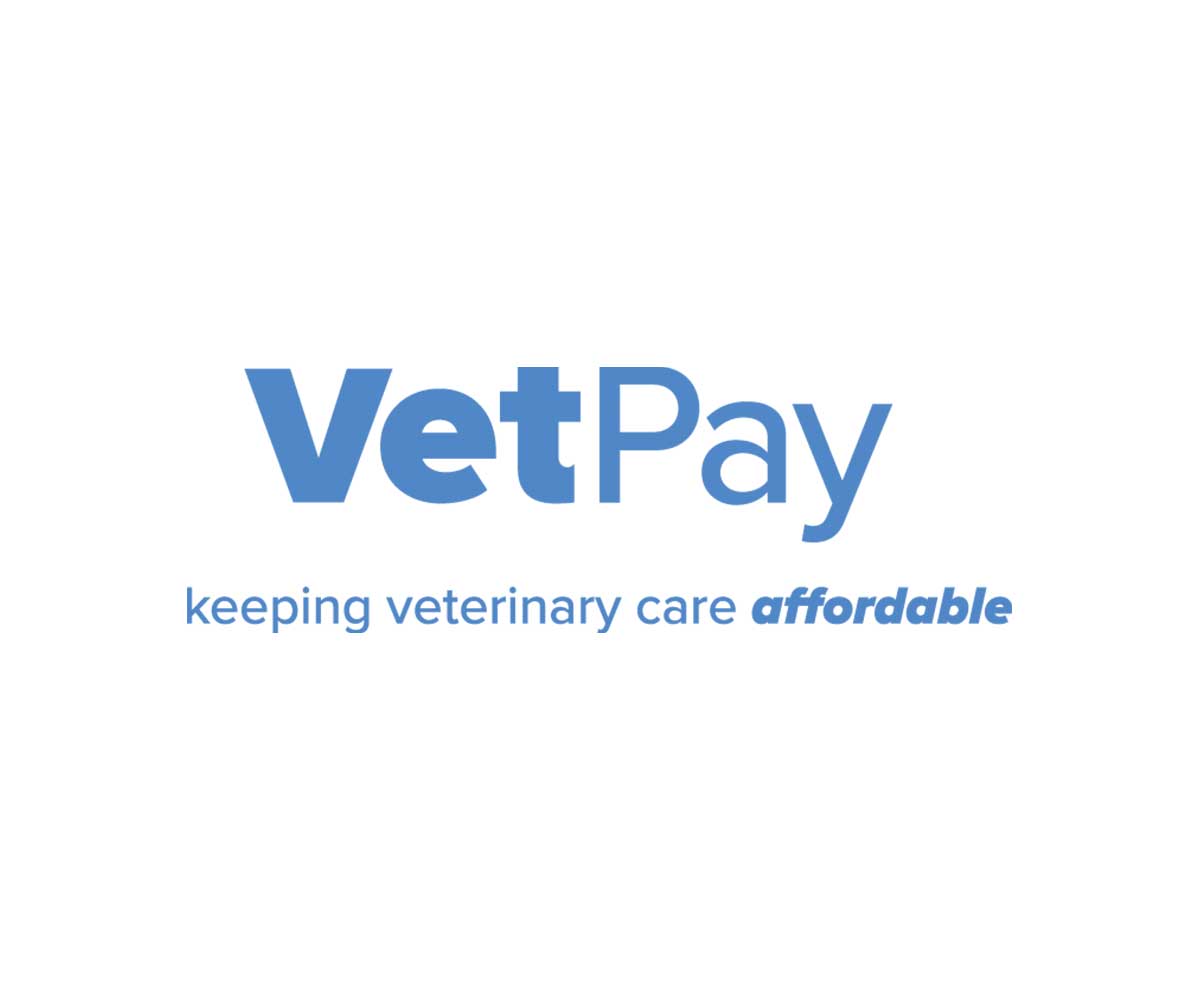
VetPay payment solutions are designed to help pet owners pay for expenses. VetPay is about starting treatment now and paying for it over time. It is a unique online processing system that takes away the angst of form-filling and offers fast approvals.
- Flexible payment options
- High approvals
- Apply online
- Pensioner’s welcome
Affordability is a key determining factor when clients decide on the level of care for their pets. Concerns over up-front costs will often lead a pet owner to decline, postpone or reduce the optimal treatment.
- Simple to use system
- No sign-up fees
- No monthly fees
- 24/7 online system1
Clients will need to apply for VetPay online and then provide you with the reference number.
Important notes to remember
- Make sure you keep a price list handy
- Make sure that you quote prices as per the price list (carefully and accurately)
- If you don’t know the price, either ask the customer to hold or ask to call them back once you have found the correct price
- Always try to collect the payment at the time of the visit or when the client returns to pick up the pet, such as when they are discharged from the hospital
- If a client is unable to pay by either a credit card or cash, try to arrange a credit agreement or vet pay (or similar)
You may find yourself working in a grooming facility or a retail outlet such as Pet Barn or Best Friends, which both combine retail and grooming services. it does not matter which one you are working in; they will have their own set of policies and procedures in regard to the facility services and fee structure and providing information to clients accurately and courteously.
You may find that the fee structure is different because of the different services that are provided. For example, in a grooming facility, the fee structures may include:
Services
| Small | Medium | Large | Extra Large | Giant | |
| Dog Bath & Towel Dry | $15 | $20 | $25 | $30 | $35 |
|---|---|---|---|---|---|
| Dog Bath & Blow Dry | $25 | $30 | $35 | $40 | $45 |
| Dog Bath & Tidy Up | $45 | $55 | $65 | $75 | $85 |
| Dog Bath & Full Groom | $60 | $70 | $80 | $90 | $110 |
The information on those services may include:
Standard Grooming Services
| Dog Bath and Towel Dry | Bath in warm water with shampoo and conditioner specifically formulated for the needs of the pet’s skin and coat and towel dry. |
|---|---|
| Dog Bath and Blow Dry | Bath in warm water with shampoo and conditioner specifically formulated for the needs of the pet’s skin and coat; blow dry; nails clipped; ears cleaned; light brush; and spray doggy cologne. |
| Dog Bath and Tidy Dry | "Bath & Blow Dry" plus removal of undercoat/groom out knots; clipping of delicate areas (groin, bottom, paw pads); and scissored tidy up of the face and feet. |
| Dog Bath and Full Groom | "Bath and Tidy Up" plus all-over body coat trim to the desired length and scissored finish. |
Payment for these services is much the same as stated above, with the exception of using VetPay. These include:
Payment
It is important to remember that your business will have a policy for payment; most retail and service facilities will have their own policy, and most facilities will state that:
- Payment is due when the services are rendered
Ideally, all fees should be collected at the end of the service provided or products are being bought. Some businesses may provide payment services such as:
- Cash
- EFTPOS
- Credit agreement
- Vet Pay
- Charge account
- Cheque
Complete Point-Of-Sale Transactions According to Policy
The first step in processing a sale is the greeting of the customer. Be courteous and friendly.
Ensure that they are happy with their choice of merchandise and give them confidence that they have made the right choice.
The next step is to finalise the transaction. This is where the cash register comes into play. You would take the following steps:
- Scan the product(s) or manually enter the product code(s) and price(s). When doing this step manually, re-check your entries before proceeding further.
- Sub-total the order
- State the amount of the order to the customer
- Accept the cash from the customer; count the cash and confirm the amount received with the customer.
- Count out the change with the customer
- Conclude the sale by printing a receipt for the customer and wrapping the goods if required.
Some businesses are part of a loyalty program. This would require you to ask if the customer was a member and if so, to enter in the customer membership details.
See an example below of a point-of-sale transactions policy and procedure from Happy Paws Animal Care Centre.
Case Study
Happy Paws Animal Care Facility Point-of-Sale Transactions
| 1. Payment Methods |
|---|
|
Accepted Payment Methods:
Card Payment Procedure:
|
| 2. Processing Payments |
|
Service/Product Entry:
Apply Discounts/Coupons:
Totalling the Transaction:
Payment Confirmation:
|
| 3. Issuing Receipts |
|
Automatic Receipt Issuance:
Digital Receipts:
Receipt Review:
|
| 4. Refunds and Returns |
|
Refund Policy:
Processing a Refund:
Refund Receipts:
|
| 5. End-of-Day Reconciliation |
|
Daily Cash Count:
POS System Reconciliation:
Reporting:
|
| 6. Security and Compliance |
|
Confidentiality:
System Security:
Compliance:
|
| 7. Customer Service |
|
Assisting with Transactions:
Transaction Disputes:
|
| 8. Training and Competency |
|
Staff Training:
Ongoing Competency:
|
Buy now pay later services like Afterpay & Zip Pay
Afterpay and Zip Pay is a buy-now, pay-later (BNPL) service that allows consumers to purchase items upfront and pay for them in four equal, interest-free instalments over a set period, typically every two weeks. Users can shop online or in-store at participating retailers and split the cost of their purchase. Afterpay doesn’t charge interest, but late fees may apply if payments are missed. It’s a popular option for budget-conscious shoppers who want to spread out payments without using credit cards.
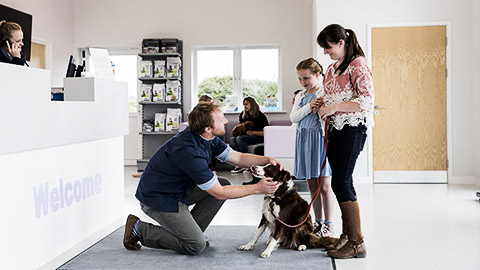
The farewell is one of the many components of a successful customer/business relationship. Customer service is building relationships to make our customers feel special and recognise that we depend on them for our business to thrive.
It’s important for staff to remember that the farewell is just as important as the greeting. The farewell gives the lasting impression of a business and can be the determining factor for a positive feeling when that customer thinks of you. The farewell is one of the easiest and most impactful steps to customer satisfaction.
When someone gives you a gift or does something for you, you ALWAYS say “Thank You.” Don't you? When someone gives us their business, it’s important to thank them. Like it or not, yours is not the only store in town, and you need to thank your customers for spending their money with you and not your competitors. You also need to tell your customers that you are happy that you have them as customers. This nuance means a lot to customers when they hear that.
An example of a proper farewell would be…
- "Thank you so much for coming to us."
- "Have a great day, and we look forward to serving you next time.”
- “Thank you, and have a nice day.”
- “Thank you, and see you next time.”
Professional and Warm
- "Thank you for choosing Happy Paws. We look forward to seeing you again!"
- "Have a wonderful day, and please don't hesitate to reach out if you need anything."
- "We appreciate your visit today. Take care, and we'll see you at your next appointment!"
- "Thank you for trusting us with your pet's care. We wish you both a lovely day!"
Casual and Friendly
- "Thank you for visiting us today! Have a great day!"
- "Take care, and give your pet a little extra love from all of us!"
- "See you next time! Wishing you and your furry friend all the best!"
- "Thanks for coming in! We hope to see you again soon!"
Empathetic and Caring
- "Take care, and we hope your pet feels better soon. We're always here if you need us."
- "Wishing you and your pet good health and happiness. We're just a call away if you need anything."
- "We're here for you anytime. Have a peaceful day, and give your pet a big hug from us!"
- "Thank you for letting us care for your pet. Have a lovely day, and give your pet lots of love!"
Customer satisfaction and retention improve when you tell your customers that their business is important to you. Customers like feeling valued and appreciated; if you do it well, they will return to you and bring their friends. If you don’t properly send our customers off, then they will find one of your competitors who will.

You must remember all the above communication methods and techniques for various situations. Your workplace procedures will have the information you need for dealing with clients, including who:
- Have inquiries about products and services
- Collecting payments
- Advising of problems with payments
- Dealing with initial complaints about products, services or staff
- Dealing with distressed clients
- Instructions from clients about products and services required
- Providing information within the limits of business policy and personal responsibility
- Referring clients to senior staff
- Reporting on animal welfare or progress
- Relaying potentially upsetting news
Use your workplace procedures for each of the above tasks to ensure the best outcome for clients and the workplace.
Watch
The next video is a TED talk about the Art of Effective Communication.
The next video is an explanation of some techniques to help you effectively communicate with people at work.
The next video is a short animation explaining effective communication skills in the workplace.
Next, see an example of an Effective Communication Policy from Happy Paws Animal Care Facility.
Case Study
Happy Paws Animal Care Centre - Effective Communication Policy
| Policy Statement |
|---|
| At Happy Paws Animal Care Centre, effective communication is essential to ensuring that our team works collaboratively and efficiently, providing the highest quality of care to the animals and service to our clients. This policy outlines the principles and guidelines for communication within the workplace to foster a positive, respectful, and productive work environment. |
| Purpose |
| This policy aims to promote clear, respectful, and constructive communication among all team members, clients, and external stakeholders. Effective communication is critical for maintaining a professional atmosphere, enhancing teamwork, and ensuring that all operational procedures are followed correctly. |
Communication Principles
|
Clarity and Precision: Communicate clearly and concisely to avoid misunderstandings. Ensure that all information provided is accurate and relevant. Respect and Courtesy: Treat all colleagues, clients, and stakeholders with respect and courtesy. Listen actively to others, valuing their input and feedback. Empathy and Understanding: Show empathy in all communications, especially when dealing with sensitive situations involving clients and their pets. Be mindful of different communication styles and adapt when necessary. Timeliness: Respond to all communications promptly, ensuring that tasks and inquiries are addressed in a timely manner. Prioritize urgent communications to maintain the smooth operation of the facility. Confidentiality: Maintain the confidentiality of all sensitive information, including client details, animal health records, and internal communications. Ensure that confidential information is shared only with authorized personnel. Professionalism: Use appropriate language in all forms of communication, whether verbal, written, or digital. Represent Happy Paws Animal Care Centre positively in all communications with clients, vendors, and the public. Constructive Feedback: Provide and receive feedback in a constructive manner, focusing on solutions and improvement rather than criticism. Encourage open dialogue to address issues and resolve conflicts. |
Communication Guidelines
| Internal Communication |
|---|
|
Meetings:
Email and Messaging:
Face-to-Face Communication:
|
| External Communication |
|
Client Interaction:
Vendor and Partner Communication:
|
| Documentation and Record-Keeping |
|
Accuracy:
Accessibility:
|
| Conflict Resolution |
|
Addressing Issues:
Escalation:
|
Implementation and Compliance
Training:
|
Consequences of Non-Compliance
Failure to adhere to this communication policy may result in disciplinary action, up to and including termination of employment, depending on the severity of the infraction.
Communication Types
A key consideration when choosing the best type of communication is looking at:
- Type of Communication: How did the original communication come through?
- Method the communication was received:
- Face to Face
- Phone
- Method the communication was received:
- Mode of Communication: The type of stakeholder.
- The stakeholder who communicated:
- Customer
- Personnel
- The stakeholder who communicated:
Here are some examples of communication types that you may engage with in your role working with animals in an animal care facility
Verbal Communication

| In-Person Meetings | Example: Discussing a pet's care plan with a client during a consultation, explaining treatment options, and answering their questions. |
|---|---|
| Phone Calls | Example: Calling clients to update them on their pet's condition after a procedure or to discuss follow-up care instructions. |
| Presentations | Example: Presenting a new service offering to potential business partners or stakeholders, outlining benefits and expected outcomes. |
Written Communication
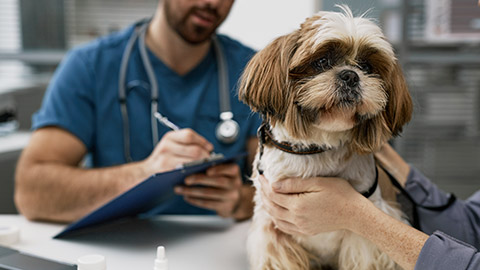
| Emails | Example: Send a follow-up email to a client summarizing the key points discussed in a meeting, including care instructions, appointments, and any additional resources. |
|---|---|
| Reports | Example: Preparing a detailed report for stakeholders on the outcomes of a recent animal welfare initiative, including data, observations, and recommendations. |
| Proposals | Example: Writing a proposal to secure funding from stakeholders for a new community outreach program focused on animal care and education. |
Visual Communication
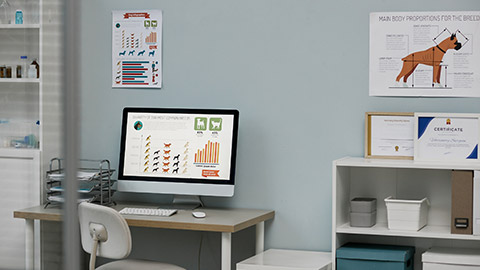
| Infographics | Example: Creating an infographic that explains the benefits of a new animal care service, which can be shared with clients and stakeholders to quickly convey key information. |
|---|---|
| Brochures and Flyers | Example: Design a brochure that outlines the services offered by your animal care facility, including pricing, to distribute to potential clients and partners. |
| Slide Decks | Example: Using a slide deck in a stakeholder meeting to visually present data, charts, and projections related to an upcoming animal care initiative. |
Digital Communication

| Social Media | Example: Posting updates on your facility’s social media channels to communicate with clients about new services, promotions, or educational content. |
|---|---|
| Webinars | Example: Hosting a webinar for stakeholders to discuss industry trends in animal care, using live chat for Q&A and engagement. |
| Online Portals | Example: Using a client portal to share pet health records, appointment reminders, and care instructions directly with clients, allowing for easy access to important information. |
Collaborative Communication

| Team Meetings | Example: Regular team meetings to discuss client feedback and refine services, ensuring all staff are aligned and aware of any changes. |
|---|---|
| Workshops | Example: Conducting workshops with stakeholders to gather input on a new project, fostering collaboration and ensuring that all voices are heard. |
| Partnership Collaboration | Example: Working closely with a local veterinarian to create a joint program, maintaining open lines of communication to ensure the partnership runs smoothly. |
Informal Communication
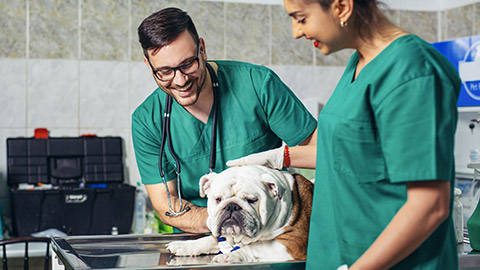
| Casual Conversations | Example: Engaging in casual, friendly conversations with clients when they visit, helping to build rapport and trust. |
|---|---|
| Text Messages | Example: Sending a quick text to a client to confirm an appointment or check in on how their pet is doing after a recent visit. |
| Networking Events | Example: Informally discussing industry trends and potential collaborations with stakeholders at a local networking event. |
Each type of communication serves a different purpose and is important in building and maintaining strong relationships with both clients and stakeholders in the animal care industry.

It is very important that you keep the appointment system carefully maintained, as this keeps the business running smoothly. In veterinary practice, it allows:
- Time for the doctors to complete treatment
- Time for the doctors to perform surgery
- Prevents customers/clients are banking up (unpleasantly long waiting) in the waiting room or a boarding facility. It prevents overbooking in busy periods, like Christmas.
Some examples of appointment or booking software that animal care facilities may use include the following:
- PetDesk
- Vetter Software
- TimeTap
- Square Appointments
- Acuity Scheduling
- Setmore
These software options provide a range of features that can help Animal Care Centre efficiently manage appointments, improve client communication, and streamline operations. Depending on the specific needs and budget of the facility, one of these solutions could be a valuable addition to the business.

Whilst working in your business, you will receive a large number of calls from people who are looking for an easy way to get a diagnosis for their pets without having to pay for the consult or are too busy to attend a consult.
The people who call but are too busy to attend can be fairly easily converted into appointments. This can be done by remaining pleasant and simply saying to the person:
- “I hear what you are saying to me, and from what you are describing to me, it sounds like something that a vet should see and be able to assist you better.”
It is important that you remember that every phone call that comes into your business could be the start of something serious for the pet, even though the owner may be making it seem trivial by stating some of the habits or changes to their normal routine. It is always more beneficial to the pet that a vet can examine the pet.
If a customer finds it necessary or uneasy about their pet's behaviour to call, they really need to come in for a consultation.
Remember, it is much better to treat a vomiting puppy or kitten when they are strong than to try and treat them once they are flat or convulsing.
Some tips and tricks to remember when having these conversations via the phone or online inquiries
- Greet and Build Rapport
- Warm Greeting:
- Start the conversation with a friendly and welcoming tone. For example, "Thank you for calling Animal Care Centre! This is [Your Name]. How can I help you today?"
- Listen Actively:
- Allow the caller to explain their needs or concerns without interruption. This shows that you value their inquiry and are attentive.
- Warm Greeting:
- Understand the Inquiry
- Ask Questions:
- Ask clarifying questions to fully understand the caller’s needs. For example, "Can you tell me more about the issue your pet is experiencing?"
- Show Empathy:
- Acknowledge their concerns with empathy. For example, "I understand how worrying that can be. We're here to help!"
- Ask Questions:
- Highlight the Benefits of an Appointment
- Explain the Value
- Clearly explain the benefits of bringing their pet in for an appointment. For example, "Our veterinarian can provide a thorough examination and recommend the best treatment to keep your pet healthy."
- Reassure the Caller
- Reassure the caller that booking an appointment is the best step to ensure their pet’s well-being. For example, "It sounds like an appointment would be the best way to address this and give you peace of mind."
- Explain the Value
- Offer a Convenient Appointment Time
- Suggest Available Slots:
- Offer specific times for an appointment. For example, "We have an opening tomorrow at 10 AM or later in the afternoon at 3 PM. Which time works best for you?"
- Be Flexible:
- If the suggested times don’t work, ask the caller for their preferred time and try to accommodate it. For example, "I can see what we have available around your preferred time. When would you be available?"
- Suggest Available Slots:
- Overcome Objections
- Address Concerns:
- If the caller hesitates or raises concerns, address them calmly and professionally. For example, if cost is a concern, you could say, "We understand that cost is important, and we can discuss the treatment options during your visit to find the best solution for you and your pet."
- Provide Alternatives
- If the caller is unsure, suggest a preliminary consultation or offer additional information that might help them decide. For example, "If you're uncertain, we could schedule a quick consultation to assess your pet's needs first.
- Address Concerns:
- Confirm the Appointment
- Summarise the details
- Once the appointment is agreed upon, summarize the details. For example, "Great, we’ll see you and [Pet’s Name] tomorrow at 10 AM for a wellness check-up."
- Provide Further Instructions
- Offer any necessary instructions or preparation tips for the visit. For example, "Please bring along any medical records you have, and make sure [Pet’s Name] hasn’t eaten for a few hours before the appointment if a blood test might be needed."
- Send a confirmation
- Confirm the appointment via email or text, including all relevant details. If your booking system allows, send a calendar invite.
- Summarise the details
- End the call positively
- Express Gratitude
- Thank the caller for considering Happy Paws and reassure them that their pet will be in good hands. For example, "Thank you for choosing (Animal Care Facility). We’re looking forward to seeing you and [Pet’s Name] tomorrow!"
- Offer Additional Assistance
- Before ending the call, ask if there’s anything else you can assist with. For example, "Is there anything else I can help you with today?"
- Express Gratitude
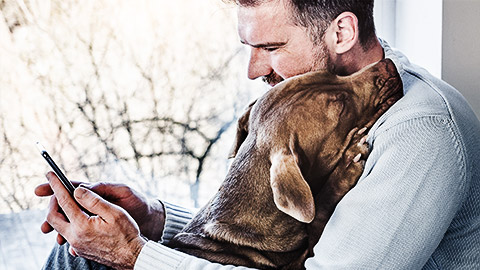
Every time a client makes an appointment, it is important that you obtain the correct information. This includes:
- The customer/client’s name
- The pet name and species
- The pet’s colour, age, de-sexed
- Whether the customers/clients have visited before or are a new client
- customers/clients address and contact details (preferred Phone numbers)
- The purpose of the visit
The client will also need to know some information (especially if they are new clients). Make sure that the client knows:
- Where the business is located
- The time of appointment (advise new clients to arrive a little earlier to complete forms)
- Any special instruction, e.g., stool sample, urine sample, do not feed pet before visit (especially if surgery is likely)
You may find that some new clients will resist making an appointment. First, they often make the excuse that they are not able to be pinned down to an exact time. It is your job to show the client the advantage of making an exact time for scheduling the appointment.
Scheduling Appointments
When scheduling the appointment, it is important to remember that most appointments normally last 15 minutes (see diagram below), but in some situations, they may need to be booked for a double (extended) appointment. These could include:
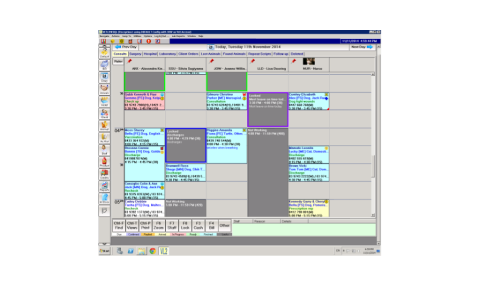
So, it is important that no matter what facility you are working in, you get to know how much time the required staff member requires for each appointment. This will vary depending on the type of consultation, such as:
- Ear checking
- Skin checks
- Behavioural
- Eyes
- Euthanasia’s
Some veterinary practices are open 24 hours, but they only have non-emergency appointments up until 6 pm during the week and 4 pm on weekends. Some businesses do not operate 24 hours; these will normally start at 8.30 and will close their doors at 7.30 pm; they have a policy that all after-hours emergencies will be referred to the 24-hour emergency centres. So, as you can see, these businesses need to have their schedule organised.
Some animal care facilities are open for 16 hours but have a staff member on duty for 24 hours.
Vaccination Appointments
When you start at your job, it is important that you observe how other staff fill out the appointment schedule, as this will give you a good idea of how long a service will normally take each client, as well as how long each vet will take to complete the appointment.
So, it is important that you ask the client when they phone up to make an appointment whether their pet has any other problems that the vet might need to know, as this could alter the length of the appointment from 15 minutes to 30 minutes.
Sick Pet Appointments

All sick pets should be booked into your clinic as soon as possible (with time permitting). For you to be able to schedule the right amount of time for the appointment, you should try to ascertain the nature of the pet’s sickness, e.g. If a small dog such as a Yorkshire terrier swallows a large rock, your vet may have to take x-rays, it the pet has gastro upset, e.g., diarrhea or vomiting, then ask the client to bring in a sample if they can.
If the pet has eaten something that may be poisonous or medication, this is classified as an emergency. Inform the client not to give any food or medication or to follow any information that they may have read on the internet as this may have a complication with the treatment that the vet may prescribe for their pet.
Emergency Appointment
When a client calls your clinic with an emergency, such as a snake bite, poisoning, Dog attack, etc.… it is important for you to remain calm. If the call is by phone try to ascertain as much information as possible about the incident, if it is a poisoning request the client to bring in the poison (e.g., rat bait, snail bait etc…) if they are able to, this will help with identification and treatment.
If the emergency is a walk-in, request the attendance of a nurse to transport the pet to the treatment area while you obtain all the owner's details and details about the incident. If the Nurse is not free, then take the pet to the treatment area and TPR (take the temperature, Heart rate and breaths) of the pet, notify the Vet and /or nurse, then return to the reception once someone has taken over and obtain all the owners’ details and details about the incident.
In any case of emergency situations, it is important that you follow your clinic policies and procedures regarding emergency bookings.
Important notes
- Keep a detailed appointment list, as this will help with clients’ files and rescheduling appointments when necessary
- Know how your vet (s) work, this will allow you to schedule appointments for the vet so that they do not overbook.
- Make sure you understand how long each procedure will take when scheduling appointments. If you have doubts as to the length, ask someone
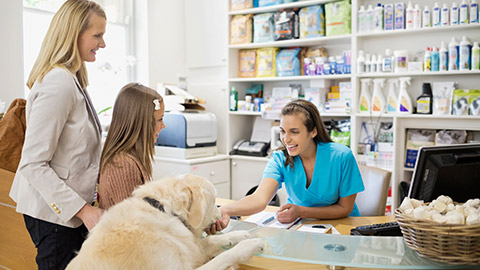
Below is an example of the process for adding new clients to your clinic appointment schedule.
| Process (What) | Who | Procedure (How & When) |
|---|---|---|
| Scheduling appointments over the telephone | Reception | Ascertain if the client has been to the clinic previous
|
| Enter New Client Details | Reception | If the client & patient have not been to the clinic previously, create a new file by choosing the client record Icon, then click on the new Choose adult or pensioner from the drop-down list, then fill in the client details, including: Last name First name Phone number Email Address (if applicable) Address (Street No & Street Name, Suburb) |
| Find out the reason for the appointment | Reception | If the client has not already mentioned the reason for the appointment, then ask open-ended questions to discover the nature of the problem. E.g., and what will be seeing “Fred for.” |
| Check if the client would like to see a specific Vet | Reception | If the client mentions they would like to see a particular vet or if a vet has been recommended to them, then try to schedule the appointment with that vet. Check the vet's availability (remember to allow at least half an hour for new clients) Check with the client if that day will suit them Check if they would like morning or afternoon Give them two options if possible (e.g., We have a 3 pm or a 5.30 pm appointment, which you would prefer). Do not ask, “What time would you like?” as this can affect appointment scheduling |
| Make the appointment | Reception | Refer to Scheduling Consultation Appointments Process and Procedure |
| Create a new client record | Reception | If a new animal/ customer presents to reception, before they can seek a medical service/ services, they need to complete a new client record |
Case Study
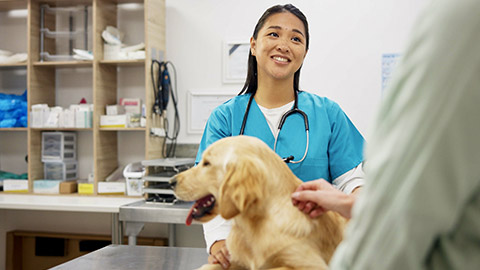
A new client is bringing their dog to the animal care facility to be groomed. You sit with the owner in the reception to complete the new client record form.
Once the owner has completed it, you need to review the form to ensure all sections of the form have been completed. Check if there is any information you may need more context about to help provide the best-tailored service for the dog and their owner.
The animal care facility uses the online software Covetrus. You add all the information into the system for the online records. Once you have completed this, you take the new client record form, scan it into the system to add to their file and then shred the original document in the paper shredder to ensure that you maintain confidentiality.

Type of Information Added to Client Records
It is important that the client records are created or updated in accordance with facility policies and procedures. Client records may include:
- Animal identification:
- Colour, markings, brands, tattoos and
- Microchip
- Name
- Sex and age
- Species/Breed
- Animal health information:
- Diet
- Known allergies
- Past or current injuries
- Past or current treatment (e.g., Vaccination status)
- Weight
- Other animal information:
- Animals' belongings
- Board or agistment records
- Breeding records
- Future appointments planned
- Regular treatments and/or services used
- Training plans
- Owner information:
- Animals that have attended this business
- Contact details
- Name
- Payment records
Collecting Information
Normally, veterinarians should only collect health information about animals with their owner's consent. It is usually reasonable to assume that consent is implied if the information is noted from details provided by the owner during a consultation, as long as it is clear that the owner understands what information is being recorded and why. It is also vital to ensure that record keeping is thorough and accurate: both to ensure the best possible ongoing treatment of a patient and, in the worst-case scenario, to be used as a defence if a case is made against a treating vet.
Obtaining All Pet Information
It is your responsibility that when animals come into your facility for any reason, it is important that you confirm the purpose of the visit; this information should be placed in the booking time slot. You may find that some owners may come up with other information that they want to discuss with the vet after the appointment has been made.
From this information, you will need to create a new record for the animal and client. This information will assist with caring for their animal and ensuring the correct treatment and/or care is provided.
Below is an example of a new client form from Happy Pawns Animal Care Facility.
Case Study
Happy Paws New Client Form
Welcome to Happy Paws Animal Care Centre! Please fill out the following information to help us get to know you and your pet better. This information will assist us in providing the best possible care for your pet.
Client Information
| Full Name | |
| Address | |
| City | |
| State | |
| Zip Code | |
| Phone Number | |
| Email Address | |
|
Preferred Method of Contact |
|
| Emergency Contact Name | |
| Emergency Contact Phone Number | |
| How did you hear about us: |
|
Pet Information
| Pets Name | |
| Species |
|
| Breed | |
| Colour/ Markings | |
| Gender |
|
| Date of Birth | |
| Microchip Number | |
| Pet Vaccinations up to date? |
|
| Current Medications | |
| Any allergies or medical conditions |
|
| Name of previous Veterinary Clinic | |
| Previous Veterinarian's Phone Number |
Services Requested
Which services are you interested in? (Check all that apply)
| Routine Check Up | |
| Vaccinations | |
| Dental Care | |
| Grooming | |
| Boarding | |
| Emergency Care | |
| Other (please specify) |
Client Authorisation and Acknowledgement
By signing below, I confirm that the information provided is accurate and complete to the best of my knowledge. I authorize Happy Paws Animal Care Centre to provide necessary care for my pet, and I agree to the terms and policies of the facility.
| Signature | |
| Date |
Thank you for choosing Happy Paws Animal Care Centre. We look forward to providing the best care for your beloved pet!

When the client phones up for an appointment, you must enter the details into the Vet Link system or in a log with the following:
- The name and Surname of the Owner
- The pets name
- The owner's contact details
- Time of the appointment
These should all be recorded on the Vet Link system or similar so that the Vet can see when and who the client is, who is coming in and what they are coming in for, how long the appointment is and whether the client may need to have blood tests or x-rays or is just coming in for a vaccination.
You will also, on occasion, place a client in the nurses/animal carer/groomer column for such treatments as nail trims, clippings, and 2nd & 3rd cartrophen visits.
When the client and their pet arrive, it is important that you complete the arrival, obtain their pet's weight and log that on the client's file, as it is important that you have the most up-to-date information, especially the weight, so that they can accurately dispense any medication.
Watch
The next video is a quick explanation of the Vet Link system.
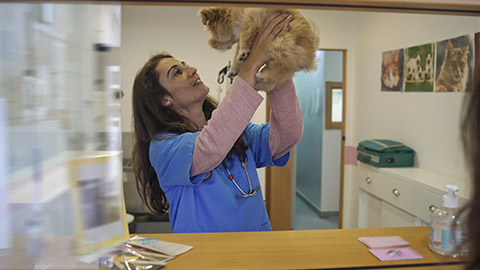
You will find that whilst you are working in your facility's reception area, you will have clients who have booked appointments, as well as clients who have just walked into your facility for their pet to see the vet/nurse or groomer and that someone is running late with their schedule. This could be due to a previous appointment (s) running overtime or an emergency that has come into your clinic, and they have had to deal with it.
It is important that you keep an eye on the clients to be able to pick up on any client that may be getting annoyed at the delay. If you notice that a client is starting to get annoyed or upset, it is important for you to defuse the situation. This can be done by letting the client know that there are delays and that the person they have an appointment with will be with them as soon as he/she can, or you might ask the client if they would like to reschedule their appointment.
You must keep all clients in the waiting room informed of any delays and assure them they will be seen as soon as possible.
Initial Arrival and Greeting
- Greet the client and pet
- Collect initial information
Intake Documentation
- Fill out and verify the intake form
- Medical History Review
Physical Assessment and Weigh-In
- Weigh the pet
- Initial physical examination of pet/animal
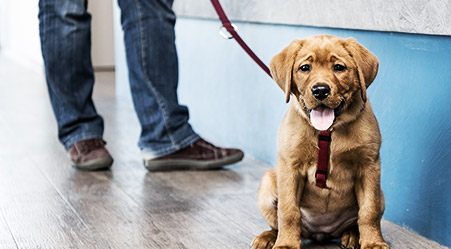
Like all animal facilities, cleanliness is of maximum importance to prevent the spread of disease, so the reception area is just as important to keep clean and tidy.
All staff members are responsible for maintaining the facility in a tidy and hygienic state. Cleaning is one of the most important tasks as it underscores the effective implementation of the principles of aseptic technique.
Clients often note the attention to detail and equate it with the ability to provide acceptable standards of service. Your nose is a very sensitive hygiene detector - follow it!
Each of the following areas will have separate cleaning utensils:
- Surgery and sterilising rooms
- Kennels
- Isolation Ward
- Treatment room, laboratory and radiography
- Waiting room, reception and offices
- Food preparation areas
- Exercise yards
Brooms, mops, buckets and other cleaning equipment are to be labelled and stored in the designated area.
Reception Cleaning Routine
Your facility will have its own cleaning routine, and you should ensure you know and understand what your role is in the cleaning of the premises.
The routine for some facilities could include:
- Clean the surfaces in the consult rooms (using Trigeine)
- Clean the surfaces in the reception area (using Trigeine)
- Vacuum the floors in consult rooms and reception
- Mop the floors in the consult rooms and reception
- Make sure you place the wet floor sign on the wet floor
Please see an example of Happy Paws Reception Cleaning Schedule for your reference.
Case Study
Happy Paws Animal Care Facility - Reception Area Cleaning Schedule
Daily Task
| Task | Responsible Person | Time | Notes |
|---|---|---|---|
| Wipe down the reception desk and counters | Receptionist | Start of the day | Use a disinfectant spray or wipes. |
| Sweep and mop the floor | Receptionist | After closing | Ensure the is dry before opening the clinic. |
| Empty trash bins | Receptionist | Mid-day & End of the day | Replace with new liners. |
| Disinfect door handles and light switches | Receptionist | Every 2 hours | Use disinfectant wipes to clean all surfaces. |
| Clean and organise the waiting area | Receptionist | Mid-day & End of the day | Ensure chairs are arranged neatly and magazines/brochures are organised. |
| Clean computer keyboards and phones | Receptionist | End of the day | Use alcohol wipes to sanitise. |
| Check and refill hand sanitisers | Receptionist | Throughout the day | Refill as needed. |
Weekly Task
| Task | Responsible Person | Time | Notes |
|---|---|---|---|
| Deep clean floor (vacuuming and scrubbing) | Cleaning staff | Every Monday | Use appropriate cleaning agents for the floor type. |
| Dust all surfaces (shelves, decorations) | Receptionist | Every Wednesday | Include any picture frames, plants, or decor. |
| Clean windows and glass doors | Cleaning staff | Every Friday | Use streak-free glass cleaner. |
| Disinfect and wipe down the seating area | Receptionist | Every Friday | Include both the seats and armrests. |
| Clean reception area air vents | Cleaning staff | Every Friday | Use a vacuum or a microfiber cloth. |
Monthly Tasks
| Task | Responsible Person | Time | Notes |
|---|---|---|---|
| Deep clean all computer equipment | IT Specialist/Cleaning staff | 1st of every month | Disconnect equipment before cleaning. |
| Polish and treat wooden surfaces | Cleaning staff | 1st of every month | Use wood-safe polish. |
| Inspect and clean light fixtures | Maintenance Staff | 15th of every month | Replace any burnt-out bulbs. |
| Steam clean chairs and upholstery | Cleaning staff | Last Friday of the month | Ensure the fabric is dry before use. |
Quarterly Tasks
| Task | Responsible Person | Time | Notes |
|---|---|---|---|
| Professional carpet cleaning | Professional Service | January, April, July, October | Coordinate with the service provider. |
| Full inventory and cleaning of supply closets | Receptionist | 1st of Monday of the quarter | Discard expired or unused items. |
| Paint touch-ups or wall cleaning | Maintenance Staff | End of each quarter | Use the same colour paint or appropriate cleaner. |
Notes:
- Ensure all cleaning supplies are stocked and accessible at all times.
- Report any damages or maintenance needs to the management immediately.
- All cleaning tasks must be initiated by the person responsible upon completion.

From time to time, you will deal with distressed and angry clients. A client could become distressed or angry for reasons including:
- Their animal gets injured while boarding
- They are not happy with the way their animal looks after a clip/groom
- The bill is more than they expected or want to pay.
Some of these scenarios may be preventable. For example, as mentioned earlier, it is extremely important to always communicate the value of a service at the time of booking or before a client books an appointment. If we communicate the value of service, there are no hidden surprises when the client comes to collect their animal.
If a client does become distressed or angry, you should:
- Listen carefully to what the client is saying
- Confirm you understand why the client is unhappy
- Notify your supervisor immediately.
Each workplace will have different policies and procedures for handling distressed or angry clients. Make sure you familiarise yourself with your workplace policies and procedures before working in the reception area. This way, you will be prepared if this situation were to arise.
Client Complaints
Clients are entitled to complain if they are unhappy with the service provided. Although we don't want to receive complaints, this is a good way to learn and address areas within the facility that may require improvement.
When a client is making a complaint, you should:
- Listen to the complaint. Acknowledge the complaint and thank the client for bringing it to your attention. Apologise, and don't blame anyone else.
- Record the details of the complaint. Go through the complaint or issue with the client and ensure you understand exactly what they are unhappy about.
- Confirm the complaint with the client. Make sure you understand what they are complaining about.
- Notify your supervisor.
In some workplaces, you may receive further training and be able to take action with complaints; however, you should never offer a resolution if your supervisor has not given you the okay.
Each workplace will have different policies and procedures for client complaints. Some clients may verbally complain but not ask for the formal process. Communicating all dissatisfied clients and complaints to your workplace supervisor is always important.
Case Study
Happy Paws Animal Care Facility - Scenario Customer Complaint
- Client: Mr Thompson
- Receptionist: Hayley
- Scene: A busy afternoon at Happy Paws Animal Care Centre. Hayley is at the reception desk when Mr. Thompson, visibly upset, approaches.
 |
Mr. Thompson: "I’m really unhappy with the service here! I brought my dog, Max, in for a grooming appointment this morning, and when I picked him up, he was still wet, and his fur was uneven. This is unacceptable!" |
 |
Hayley: [Maintaining a calm and empathetic tone] "Mr. Thompson, I’m so sorry to hear that you’re unhappy with Max’s grooming. That’s certainly not the level of service we strive to provide here at Happy Paws. Let’s see how we can make this right." |
 |
Mr. Thompson: "I’ve been coming here for years, and I’ve never had an issue before. But this? This is just poor service!" |
 |
Hayley: [Nods understandingly] "I completely understand your frustration, and I appreciate you bringing this to our attention. We value your loyalty and Max’s well-being, so it’s really important to us that you’re satisfied with our services." |
 |
Mr. Thompson: "Well, what are you going to do about it? I paid good money for this!" |
 |
Hayley: [Politely and supportively] "Here’s what I suggest: I can arrange for Max to be seen by our senior groomer immediately, at no additional charge, to ensure he looks exactly how you’d like him to. We can also offer you a discount on your next grooming session as a token of our appreciation for your understanding. Would that be acceptable to you?" |
 |
Mr. Thompson: [His tone softening] "Well, I appreciate that, but I’m really in a hurry today. Can you make sure this doesn’t happen again?" |
 |
Hayley: [Respectfully and reassuringly] "Absolutely, Mr Thompson. I’ll personally make sure that Max’s grooming records are updated with your preferences and that our team is aware of your feedback to avoid any future issues. We’ll follow up with you before your next appointment to confirm all the details." |
 |
Mr. Thompson: [Sighs, feeling more at ease] "Okay, that sounds fair. I want Max to get the best care." |
 |
Hayley: [Smiling warmly] "And that’s exactly what we want, too. Thank you for giving us the chance to make it right, Mr. Thompson. If there’s anything else I can do for you, please don’t hesitate to let me know." |
 |
Mr. Thompson: "Thanks, Hayley. I appreciate it." |
 |
Hayley: |
The scene ends with Mr Thompson leaving the clinic, feeling reassured that his concerns were taken seriously, and Hayley documenting the interaction in Max’s records.
Key Points of De-escalation:
|
